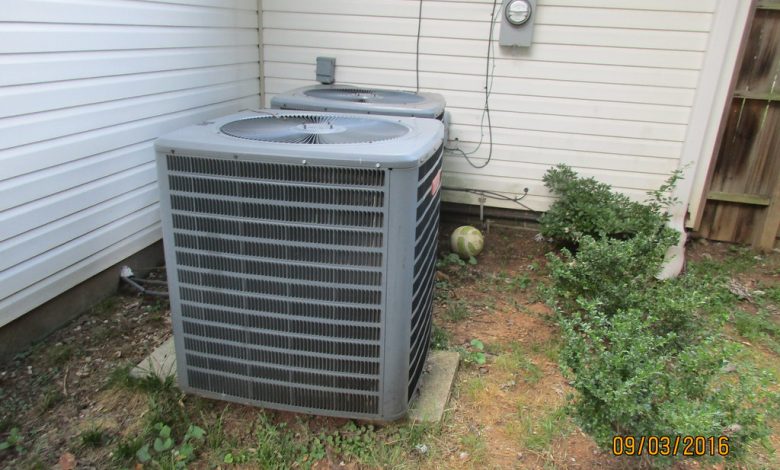What Are HVAC System Parts? A Comprehensive Overview Of Objectives Of HVAC Systems

Introduction
An HVAC (heating, ventilation, and air conditioning) system is a critical component of any modern building, providing the necessary heating, cooling, and ventilation to ensure comfort and safety for occupants. The many elements and components that make up these systems ensure the efficient operation of HVAC systems. We will go into great depth on each component of an HVAC system in this post.
HVAC systems, short for Heating, Ventilation, and Air Conditioning, are complex systems designed to regulate indoor temperature, humidity, and air quality in residential, commercial, and industrial buildings. Understanding the various parts of an HVAC system is crucial to comprehend how it operates and maintains indoor comfort effectively.
· The thermostat
The thermostat is the HVAC system’s brain, regulating the temperature by turning the heating or cooling system on and off as required. The thermostat can be a simple analog device or a more advanced digital system with programmable settings and remote access features.
· Furnace
The furnace is the primary component of the heating system, responsible for producing warm air distributed throughout the building. Various fuels, including natural gas, propane, or electricity, can power furnaces.
· Heat Exchanger
The heat exchanger is an essential component of the furnace that moves heat from the fuel source to the air. The heat exchanger is typically made of metal and can crack or corrode over time, leading to potential safety hazards.
· Air Handler
The air handler moves the air through the HVAC system. It typically includes a blower fan, air filter, and dampers to control airflow. The air handler can be located in various building areas, including the attic, basement, or utility room.
· Evaporator Coil
The cooling system’s evaporator coil is in charge of removing heat from the interior air. The coil is typically made of copper or aluminum and is located inside the air handler or above the furnace.
· Condenser Coil
The condenser coil is another cooling system component that releases heat to the outdoor air. The condenser coil is typically located outside the building, often in a unit called a condenser.
· Refrigerant Lines
The pipes connecting the condenser and evaporator coils are known as refrigerant lines. These lines are typically made of copper or aluminum and are filled with refrigerants like Freon or Puron.
· Compressor
The refrigerant is compressed and forced through the refrigerant lines by the compressor, which serves as the brains of the cooling system. The compressor can be located inside the condenser or as a standalone unit.
· Ductwork
The system of pipes that distributes air throughout a structure is called ductwork. The ductwork may be constructed from various materials, such as flexible plastic, fiberglass, or sheet metal. The ductwork must be installed and maintained properly to guarantee adequate airflow and system performance.
· Vents and Registers
Vents and registers are the outlets that allow air to enter the building. These components can be located on walls, floors, or ceilings and can be adjusted to control airflow.
An HVAC system is a complex network of parts and components that work together to provide a comfortable and safe environment for building occupants. To perform effective maintenance and troubleshooting, it is crucial to comprehend the many components of an HVAC system. Frequent inspections and maintenance of HVAC systems may maintain effective functioning and help prevent malfunctions. Contacting a licensed HVAC technician for any repairs or maintenance needs is always recommended to ensure the safe and proper operation of the system.
Read More: What Are Candy Wives? An Essential Overview Of How Is A Candy Wife Made And Its Types
Objectives of HVAC Systems
Modern buildings must include HVAC (Heating, Ventilation, and Air Conditioning) systems to ensure the comfort and safety of their residents. An HVAC system aims to provide a healthy and cosy interior environment by regulating temperature, humidity, and air quality. This article will discuss the various objectives of HVAC systems in detail.
1. Comfort Control
Creating a comfortable interior atmosphere is an HVAC system’s main goal. This is accomplished by regulating the temperature, humidity, and air quality to a cozy level for the people within. A suitable interior environment may dramatically impact productivity, health, and well-being. A well-designed and maintained HVAC system can provide a comfortable and healthy home atmosphere.
2. Energy Efficiency
Another objective of HVAC systems is to operate efficiently and save energy. HVAC systems consume significant energy, making them one of the largest energy-consuming systems in buildings. Therefore, energy efficiency is an essential factor to consider when designing and operating HVAC systems. An energy-efficient HVAC system may cut energy expenditures, operational expenses, and the carbon footprint of the building.
3. Indoor Air Quality
Another key goal of HVAC systems is to maintain appropriate indoor air quality. Inadequate indoor air quality can hurt occupant comfort, productivity, and health. HVAC systems can help improve indoor air quality by removing contaminants such as dust, pollen, and bacteria from the air. HVAC systems may also assist with humidity regulation, which helps stop mold and mildew development.
4. Ventilation
Ventilation is another crucial objective of HVAC systems. Proper ventilation ensures an adequate supply of fresh air in the building. Ventilation helps remove stale air and pollutants from the building, improving indoor air quality. Depending on the building’s design and occupancy, HVAC systems can provide natural and mechanical ventilation.
5. Thermal Comfort
HVAC systems are responsible for maintaining thermal comfort in buildings. The mental state communicating happiness with the thermal environment is thermal comfort. HVAC systems can control the temperature, humidity, and air movement to provide a comfortable indoor environment. This is achieved using heating, cooling, and air circulation equipment to maintain a comfortable indoor temperature.
6. System Reliability
A fundamental goal of HVAC systems is reliability. To keep an interior environment comfortable and healthy, HVAC systems must perform consistently. Uncomfort, health issues, and decreased productivity might result from an HVAC system that is not properly maintained or is unreliable. HVAC systems can function reliably and effectively with regular maintenance and inspections.
7. Noise Control
Noise control is another objective of HVAC systems. HVAC systems can produce noise that can be a nuisance to occupants. Therefore, noise control is an essential factor to consider when designing and operating HVAC systems. HVAC systems can be designed with noise-reducing features such as sound-absorbing materials, ductwork insulation, and vibration isolation.
8. Cost-Effectiveness
Cost-Effectiveness is another objective of HVAC systems. HVAC systems can be expensive to operate and maintain. Therefore, it is important to design and operate cost-effective HVAC systems. This can be achieved by selecting energy-efficient equipment, implementing regular maintenance programs, and optimizing the system’s operation.
HVAC systems are crucial to modern buildings, providing comfort, safety, and energy efficiency. The objectives of HVAC systems include comfort control, energy efficiency, indoor air quality, ventilation, thermal comfort, system reliability, noise control, and cost-effectiveness. By considering these objectives when designing and operating HVAC systems, building owners and operators can ensure that the indoor
HVAC System Selection to Choosing the Right System for Your Building
Building Size and Type
The first factor to consider when selecting an HVAC system is the size and type of the building. The HVAC system should be appropriately sized to meet the heating and cooling demands of the building. The type of building, such as commercial, industrial, or residential, can also impact the HVAC system selection.
Climate Conditions
Another important thing to consider when choosing an HVAC system is the climate. The HVAC system needs to be built with the location’s unique climate in mind. For instance, a building in a warm, humid environment would need a different HVAC system than one in a cold, dry region.
Energy Efficiency
Energy efficiency is an essential factor to consider when selecting an HVAC system. Energy-efficient HVAC systems can cut energy costs, operational expenses, and the carbon footprint of the building. Energy-efficient HVAC systems can also qualify for various rebates and incentives governments and utility companies offer.
System Performance and Reliability
When choosing an HVAC system, performance and dependability are crucial. The HVAC system must be constructed and designed to fulfill the needs of the building and perform consistently. Uncomfortable conditions, health issues, and decreased productivity might result from an unstable HVAC system.
Ambient Air Quality
Another important consideration when choosing an HVAC system is indoor air quality. By eliminating impurities, managing humidity levels, and offering sufficient ventilation, the HVAC system should be built to deliver good indoor air quality. Inadequate indoor air quality can harm occupant comfort, productivity, and health.
Maintenance and Serviceability
Maintenance and serviceability are important factors when selecting an HVAC system. The HVAC system should be easy to maintain and service to ensure reliable and efficient operation. The system should also be designed with accessible components and spare parts availability to minimize downtime in case of repairs.
Cost
When choosing an HVAC system, the cost is an important consideration. The HVAC system’s initial, ongoing, and maintenance expenditures should be considered while choosing the system. It is essential to balance the system’s cost with its performance, reliability, and energy efficiency to ensure a cost-effective solution.
System Type
Finally, the type of HVAC system is crucial when selecting an HVAC system. The most popular HVAC system types include heat pumps, packaged air conditioners, split air conditioners, and central air conditioners. Every system type has a set of distinctive characteristics, benefits, and drawbacks. The selection of the HVAC system should be based on the building’s specific requirements and the factors discussed above.
Selecting the right HVAC system for your building requires careful consideration of various factors, including building size and type, climate conditions, energy efficiency, system performance and reliability, indoor air quality, maintenance and serviceability, cost, and system type. By considering these factors, building owners and operators can select an HVAC system that provides a comfortable and healthy indoor environment, operates reliably and efficiently, and is cost-effective.
What is a Basic HVAC System?
A basic HVAC system typically consists of several components that work together to provide heating and cooling to the indoor space.
Furnace or Heat Pump
The furnace or heat pump is the HVAC system component responsible for heating the indoor space. A furnace is typically used in colder climates, while a heat pump is used in milder climates. The furnace or heat pump heats the air distributed throughout the building through a ductwork system.
Air Conditioner
The air conditioner is the HVAC system component responsible for cooling the indoor space. The inside air is cooled and dehumidified by an air conditioner before being sent outside. A ducting system is then used to transport the cooled air throughout the whole structure.
Ductwork
Pipes or tubes called ductwork are used to transfer warm or cooled air across a structure. Flexible plastic, fibereglass, or sheet metal are often used to create ducting. The ductwork should be designed and installed correctly to ensure efficient and effective air distribution throughout the building.
The thermostat is the HVAC system’s component that controls the indoor space’s temperature and humidity levels. The thermostat can be programmed to maintain a specific temperature and humidity level and adjust manually to meet the occupants’ comfort needs.
Air Filter
The air filter is the HVAC system that removes dust, dirt, and other particles from the indoor air. The air filter should be regularly cleaned or replaced to ensure proper air quality and prevent the HVAC system from overworking.
Ventilation System
The ventilation system is the HVAC system component responsible for exchanging indoor air with outdoor air to maintain good indoor air quality. The ventilation system can be natural, such as opening windows or doors, or mechanical, using fans or air exchange units.
Dampers are the components of the HVAC system that regulate airflow in the ductwork system. Dampers can be adjusted to redirect air to specific building areas, allowing for more efficient heating and cooling.
Conclusion
A basic HVAC system comprises several parts that provide the interior space with heating, ventilation, and air conditioning. The components include the furnace or heat pump, air conditioner, ductwork, thermostat, air filter, ventilation system, and dampers. Understanding a basic HVAC system’s components can help owners and operators ensure proper maintenance, efficient operation, and occupant comfort.
FAQs
Apart from this, if you are interested to know more about Why Your Aircon is Noisy: 4 Causes and Solutions then visit our Home Improvement category.


